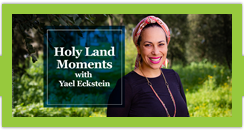Daily Devotional
Sunshine on a Rainy Day
August 4, 2019 - 12:00 amThis Devotional's Hebrew Word
Send me your light and your faithful care,
let them lead me;
let them bring me to your holy mountain,
to the place where you dwell. — Psalm 43:3
At sundown Aug. 10, Jews around the world commemorate Tisha B’Av, a time of mourning that marks the many tragedies that befell the Jewish people throughout history on this particular date. Yet from this time of sorrow comes a ray of hope. This is one of nine devotions from the timeless teachings of Rabbi Yechiel Eckstein exploring how we can find comfort in the depths of tragedy and transform darkness into light. To learn more about Tisha B’Av, download a copy of our complimentary Bible Study.
In the final stanza of the poem The Rainy Day by Henry Wadsworth Longfellow, we find the oft quoted line: “Into each life some rain must fall.” It’s a truism that everyone comes into hard times. As the poet explains, “Thy fate is the common fate of us all . . . some days must be dark and dreary.” Given this inevitable reality, the question is not whether we will receive challenges, but rather how we will receive them.
So many times, we get stuck in the muck of a “rainy day.” It’s hard to see past the gloom and move on to a brighter future.
Psalm 43 recounts the destruction of the Temple and the harsh exile of the Jewish people from Israel. However, this psalm really speaks to anyone who has gone through any type of destruction in his or her life. In the first half of the psalm, the psalmist asked, “Why have you rejected me? Why must I go about mourning, oppressed by the enemy?” (v.2). He bemoaned the very rainy day he found himself in.
However, the psalmist didn’t stop there. With a distinct shift in tone, the psalmist asked: “Send me your light and your faithful care, let them lead me; let them bring me to your holy mountain, to the place where you dwell.” The psalmist envisioned and prayed for a brighter future. In the midst of destruction, he could already see the reconstruction of the Temple. He could see the return of the exiles and the renewed joy in the Temple service. It is that vision – that light – which led him through the dark and dreary day.
Friends, when we go through the rainy days of our lives, it is so important to hold a vision for the future that will see us through our darkest hours.
A friend of mine recently vacationed in a remote area of Europe. The couple stayed at a magnificent vineyard that had become a popular tourist destination complete with villas for vacationers. In speaking with the vineyard’s owner, my friend learned that the vineyard was 20 years in the making. The owner described the difficulties he encountered in the early years and through the first 15 years of pursuing his dream. “What kept you going?” she asked him. “I always knew it would succeed,” the owner explained. “I saw what exists today from the very beginning.”
The psalmist concluded his lament in this way: “Why, my soul, are you downcast? . . . Put your hope in God, for I will yet praise him . . .” (v.5). Or, as Longfellow wrote: “Be still, sad heart and cease repining; Behind the clouds is the sun still shining.” Even on the dreariest days, we need to see the sun behind the clouds and the clear skies that follow the rain.

